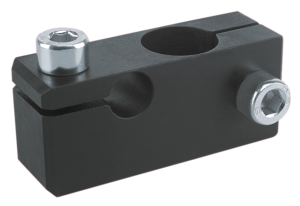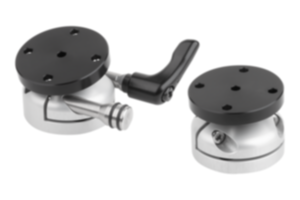Rubber buffers by norelem - Efficient damping solutions for industry and technology
What are rubber buffers?
The advantages of rubber buffers
Wide range of uses - rubber buffers for numerous applications
Where are rubber buffers used for?
The economical solution for your damping requirements - rubber buffers by norelem
Rubber buffers by norelem - Efficient damping solutions for industry and technology
Rubber buffers by norelem are popular design and standard elements for elastic mounting. They are part of the product group of stops and are used in many technical and industrial applications. The main task of vibration mounts is to limit movements, absorb shocks and protect mechanical systems from damage.
Due to their elastic properties, stop buffers absorb forces, dissipate such forces in a controlled manner and effectively dampen vibrations. For this purpose, they are typically installed at the end positions of moving parts. There, they prevent hard stops and increase service life of components involved.
Their versatility is evident in a wide range of applications, from machine construction and automotive engineering to the construction industry. Here they decisively contribute to reducing wear, noise emission and mechanical damage.
What are rubber buffers?
Rubber buffers are damping components or stop elements. They are also known as stop buffers and are made up of a combination of elastic materials and fastening elements. This combination offers a sturdy and durable solution for various technical applications.
The structure of a vibration mount, briefly explained:
The rubber core is the key component of the buffer. It is made of elastic material, such as natural or synthetic rubber (silicone).
The material ensures that the stop buffer absorbs forces, dampens vibrations, and limits movement. The properties of rubber, such as grade of hardness, temperature, and ageing resistance, are selected according to area of application.
Rubber buffers by norelem have integrated metal parts, such as threaded pins, washers or plates. These ensure easy fastening and secure connection to the surrounding area.
The metal parts are made of steel, stainless steel or A4 stainless steel to ensure strength and corrosion resistance.
For special applications, the rubber can be provided with protective layers (coating). These render it more resistant to chemicals, UV radiation or extreme temperatures.
You would like to integrate a vibration mount into your system, but don't yet know which one is most suitable? We provide free CAD data for the products on offer. Download and check suitability of the buffers.
The advantages of rubber buffers
Rubber buffers offer a number of advantages. A key aspect is their ability to effectively dampen vibrations and shocks. This protects machines and system from damage that could be caused by mechanical influences.
At the same time, stop buffers help reduce noise and vibrations. This not only improvesfunctionality of the systems, but also creates a safer, more pleasant working environment.
Another advantage of stop buffers is their versatility. They are available in different shapes, sizes and degrees of hardness. This makes them suitable for a wide range of applications.
Among other things, they can be used in a wide temperature range from -30 to +80 °C. For this feature they are perfect for applications in a wide variety of environments. Whether in cold outdoor areas or in machines with increased heat generation.
stop buffers are cost-effective as they are easy to install and maintain. The use of high-quality rubber compounds in the manufacturing process rubber buffers are resistant to wear and tear. Their durability reduces the need for frequent replacement or repairs, which saves time and money
in the long term.
Wide range of uses - rubber buffers for numerous applications
The variety of these products creates different application possibilities. For different mounting requirements, norelem offers stop buffers with internal or external thread. Depending on their design, rubber buffers absorb energy according to its shape. Our online shop offers individual buffers in different degrees of hardness.
The vibration mounts can therefore be used variably in any machine environment.
Where are rubber buffers used for?
Rubber buffers are used for thrust and tension loads in a wide variety of applications. Stop buffers by norelem are much less load bearing under tension loads than under compressive loads. For load data can see the technical information page.
In industry and craft, they absorb kinetic energy. In addition, stop buffers are used in the mounting of aggregates, motors, compressors, pumps and inspection machines. Buffers are also frequently used as door stops or noise damping elements.
Our rubber buffers
Our range includes rubber buffers of various types. Respective type of rubber buffer indicates how the buffer including its thread can be integrated into particular application.
- Type A features an external thread on both sides.
- Buffer Type B can be installed with one internal and one external thread.
- Rubber buffers of product category Type C features an internal thread at both ends.
- The stop buffer in product category Type D features an external thread and a natural rubber coating on visible surfaces. This serves as a bump stop to limit spring travel of moving masses.
- Like Type D, the stop element Type E features a natural rubber coating on visible surfaces. Type E differs by its thread. norelem rubber buffers Type E feature an internal thread.
The different styles
Rubber buffers by norelem offer versatile solutions for vibration absorption, shock protection and noise reduction. Available in various sizes, shapes and materials, they are perfect for a wide range of applications in industry and machine construction.
Buffers differ in several ways. Besides the rubber buffer suction foot and a door buffer, other styles are also available. For more detail see below.
Tapered rubber buffers
A tapered rubber buffer is a specially shaped buffer element that allows for targeted distribution of forces through its centre. In the event of radial deflection, the tapered rubber contour reduces high edge loads on the rubber. This increases the service life of the component. The tapered shape also allows flexible adjustment to different loads.
The stop buffer is made of high-quality natural rubber with a medium hardness of 57° Shore A offering optimum balance between flexibility and stability.
Metal parts are made of electro zinc-plated steel, making them corrosion resistant. With a grade of 5.6, the steel guarantees high load-bearing capacity and a long service life.
The combination of sturdy material and sophisticated design makes the tapered rubber buffer versatile.
Rubber buffers by norelem of Type A and C are available tapered.
Parabolic rubber buffer vs. conical rubber buffer
The parabolic shape allows fore forces acting on the buffer being evenly distributed and effectively absorbed. The advantage of the shape is that it offers a progressive spring characteristic. Resulting in resistance increasing with increasing deformation. This makes parabolic rubber buffers suitable for a wide range of load scenarios.
Bump stops feature an external thread and a tapered, elastomeric rubber cover made of natural rubber. The parabolic rubber buffer is mainly primarily when effective cushioning or shock absorption is required. Tapered buffers absorb heavy impact loads well.
In contrast, conical rubber buffer stand out due to their conical design. It differs from the parabolic rubber buffer mainly in its shape. Conical stop buffers are not tapered, but has the same shock-absorbing properties.
Spherical rubber buffer
Spherical rubber buffers by norelem feature an internal thread and are also used to cushion and dampen shocks. They have a spherical, rounded shape.
This special design allow for even distribution of forces and optimum absorption of oscillations, shocks and vibrations. Spherical vibration mounts are made of high-quality natural rubber, which is available in two degrees of hardness:
- 55° Shore A for softer applications
- 70° Shore A for higher loads
Metal parts of the buffer are made of electro zinc-plated, grade 5.6 steel. This ensures a higher corrosion resistance and durability.
The economical solution for your damping requirements - rubber buffers by norelem
Vibration mounts by norelem help dampen and absorb vibrations on the machine. They are characterised by sturdiness and effective dampening and shock absorption. Besides stop elements, the range also includes accessories for rubber buffers such as rubber buffer impact rails or O-form mounts.
The rubber impact buffer rails are used to absorb large impact forces and mounting large masses. The rubber impact buffer rails are available in black painted or electro zinc-plated steel.
The O-form mount made of electro zinc-plated steel features a very soft spring characteristic. This is why they are also referred to as low-frequency bearings. O-form mounts contribute to the low-vibration mounting of instruments and electrical components. It can also be used to fasten light units and precision mechanical devices.



















